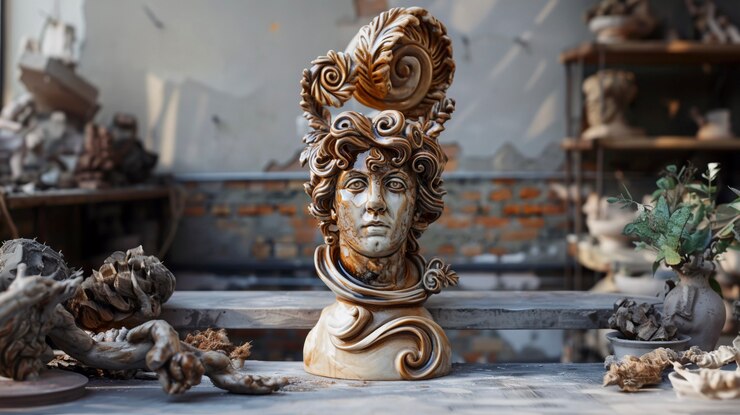Art serves as a mirror reflecting the culture and values of its time. To truly understand its evolution, we must delve into ancient civilizations’ art. These early artistic expressions provide valuable insights into how our ancestors lived, believed, and created. This exploration of ancient artz offers a window into early societies’ creative and cultural achievements.
The Birth of Art in Ancient Times
Art has been a cornerstone of human civilization for millennia. Early art forms went beyond mere decoration; they played essential roles in rituals, storytelling, and recording historical events. Let’s explore the different facets of early artistic expression.
Prehistoric Artistic Endeavors
Prehistoric art includes some of the earliest surviving artworks from the Paleolithic and Neolithic eras. These pieces are crucial for understanding early human societies.
- Cave Paintings: The Chauvet Cave in France, discovered in 1994, features some of the oldest cave paintings, estimated to be around 32,000. These artworks depict animals like horses and bison, reflecting early humans’ deep connection with their environment.
- Petroglyphs: Found worldwide, petroglyphs are rock carvings that often feature abstract designs and animal figures. They provide insight into the symbolic and ceremonial practices of ancient peoples.
- Venus Figurines: Sculptures like the Venus of Willendorf are small, often exaggerated depictions of female figures. Scholars believe these figurines may have symbolized fertility or ideal beauty standards.
The Art of Ancient Egypt
Ancient Egyptian art is celebrated for its distinctive style and religious significance. Art from this civilization, flourishing along the Nile, showcases symbolic and conventional approaches.
- Hieroglyphics: Egyptian art frequently integrated hieroglyphic writing, a complex system of pictorial symbols. These symbols conveyed religious texts, royal decrees, and monumental inscriptions, blending text with imagery.
- Statues and Reliefs: Egyptian art is famous for its statues and reliefs depicting gods, pharaohs, and influential figures. These works aimed to immortalize their subjects, honoring their divine or royal status.
- Tomb Art: Art in tombs and burial chambers aimed to ensure a favorable afterlife. Elaborate wall paintings, caskets, and grave goods reflect the deceased’s status and beliefs, offering glimpses into ancient funerary practices.
Mesopotamian Art Innovations
Art from ancient Mesopotamia, located between the Tigris and Euphrates rivers, includes remarkable advances in sculpture and architecture. This region saw the rise of various civilizations, such as the Sumerians, Akkadians, Babylonians, and Assyrians.
- Ziggurats: These massive step pyramids were religious temples and central to Mesopotamian urban planning. Their grandeur underscores the significance of religion in Mesopotamian culture.
- Cylinder Seals: Cylinder seals are small engraved stones used for stamping clay tablets, often depicted in mythological scenes. They were used to mark documents or personal belongings, providing insights into administrative practices.
- Bas-Reliefs: The Assyrians created detailed bas-reliefs for palace walls, depicting scenes of military conquests, hunting, and divine interactions. These artworks celebrated victories and divine favor.
Contributions to Ancient Greek Art
Ancient Greek art is renowned for its focus on realism and humanism. Greek artists made significant contributions to sculpture, pottery, and architecture.
- Sculpture: Greek sculptors such as Phidias and Praxiteles are known for their idealized portrayals of the human form. Their use of naturalistic poses and detailed anatomical features marked a significant advancement in artistic techniques.
- Pottery: Greek pottery, particularly from Athens, features intricate designs and vivid scenes from mythology, daily life, and athletic events. Techniques such as black-figure and red-figure painting allowed for elaborate and expressive designs.
- Architecture: Greek architecture, exemplified by structures like the Parthenon, demonstrates principles of symmetry, proportion, and aesthetic beauty. The three classical orders—Doric, Ionic, and Corinthian—continue to influence architectural design.
Roman Artistic Achievements
Roman art was greatly influenced by Greek precedents but developed its distinctive characteristics. Romans excelled in adapting artistic styles from the regions they conquered.
- Realism: Roman art is known for its realistic portrayal of individuals, as seen in detailed busts of emperors and prominent figures. This focus on accuracy highlights Roman values of personal achievements and virtues.
- Mosaics and Frescoes: Romans created intricate mosaics and frescoes for public and private spaces. These artworks often depicted mythological stories, historical events, and everyday life, showcasing their skill in decorative art.
- Architecture: Roman engineering innovations, including concrete development, led to the construction of monumental structures like the Colosseum and aqueducts. These achievements allowed for impressive architectural designs and public infrastructure.
The Lasting Influence of Ancient Artz
The artistic achievements of ancient civilizations continue to inspire modern culture. By studying these early artworks, we gain a deeper understanding of their creators’ values and achievements.
Modern Artistic Inspirations
Contemporary artists frequently draw inspiration from ancient art, incorporating classical themes and techniques. The revival of classical themes during the Renaissance and integrating ancient motifs in modern design demonstrate a continued appreciation for early artistic traditions.
Preservation and Research
Preserving and studying ancient art is vital for understanding human history. Archaeologists, historians, and art conservators work to protect and interpret these invaluable artifacts. Museums and research institutions are crucial in making ancient art accessible and ensuring its continued study.
Conclusion
Exploring ancient artz provides profound insights into early civilizations’ creative and cultural achievements. From prehistoric cave paintings to Roman architectural marvels, these artworks reveal the rich tapestry of human expression and innovation. By preserving and studying these ancient masterpieces, we honor the legacy of our ancestors and enhance our appreciation of artistic creativity.
